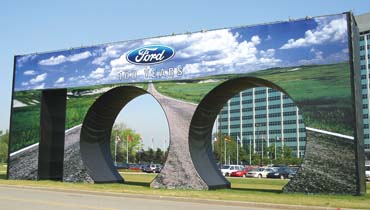Screen and digital printers that specialize in graphics production have access to an enormous variety of rigid and flexible media for short- and long-term indoor and outdoor use. Papers, plastics, foam-cored products, coated metals, wood, glass, and other materials give graphics shops what amounts to a Swiss Army Knife of substrates. But even with all of these choices, fabrics remain among the most popular printable materials available. Fabrics can be used very effectively for many traditional graphics applications, such as banners and P-O-P displays. And with their durability and flexibility, they also are ideal for a variety of specialty applications.
Printable fabrics are available in a wide range of weights and finishes. Need something soft, light, and flexible for indoor use? Fabrics fit the bill. Do you require something a little heavier and stiffer for an outdoor job? You can find those qualities in fabrics, too. But before we delve into the many uses for printable fabrics, let’s consider the types of materials that are available and the ways in which they are constructed. Then, we’ll examine some of the considerations to keep in mind when working with these media. Finally, our focus will shift to the applications for which printable fabrics are best suited, including several that may come as a surprise.
Material makeup
What do the leisure suits of the 1970s have in common with fabric substrates? Polyester. Even though the groovy get-ups of the disco age are a thing of the past, graphics media have kept polyester in style. In fact, polyester-based substrates command a majority of the printable-fabric market.
Part of polyester’s popularity stems from improvements in the manufacturing process. Polyester no longer has to be a tough, stiff material. Scott Fisher, president of Indian Trail, NC-based Fisher Textiles, explains that a combination of the right yarn, construction method, and finish can produce a printable fabric that feels like cotton or silk. Demand for polyester fabric also remains steady because printers can use a variety of imaging methods to decorate it.
“Polyester is the fabric most used for screen- and digitally printed graphics,” Fisher says. “Nylon has a big piece of the flag market; however, everything else seems to be going to polyester.”
Fine-art printing is a market niche that usually sets itself apart from commercial graphics in job volume and substrate selection. Cotton and cotton/polyester blends are often used to lend a more authentic look and feel to fine-art prints. These materials are soft and flexible, and a gesso coating adds to their realistic look and enhances printability. Your clients may specify 100% cotton as the vehicle for their greatest inspirations, but decorating all-cotton substrates can be an art form on its own.
Ed McCarron, marketing manager for South Hadley, MA-based InteliCoat, explains that cotton isn’t extremely stable or consistent because it’s a natural product. “It can shrink or expand dramatically,” he says. “That’s the driver for polyester. It’s a synthetic fiber, so it’s much more stable. Blending a ratio of cotton and synthetic gives you the best of both worlds. A great example of that is canvas. You get the look and feel of cotton, but you also have the dimensional stability of polyester in there.”
Weaving and knitting are the most common methods used to produce printable fabrics. A woven fabric consists of two sets of yarns. The warp threads run lengthwise along the fabric. The weft (or fill) is perpendicular to the warp. An over-and-under weave of the warp and weft yarns holds the fabric together. Knitted fabrics are made from a single set of yarn. The yarn fibers may run either lengthwise along the fabric or across the fabric’s width. Looping the yarns around each other holds the fabric together.
The materials are considered greige (pronounced gray) goods

 Case Studies2 months ago
Case Studies2 months ago
 Art, Ad, or Alchemy2 months ago
Art, Ad, or Alchemy2 months ago
 Andy MacDougall2 months ago
Andy MacDougall2 months ago
 Columns3 weeks ago
Columns3 weeks ago
 Editor's Note3 weeks ago
Editor's Note3 weeks ago
 Marshall Atkinson3 weeks ago
Marshall Atkinson3 weeks ago
 Thomas Trimingham2 months ago
Thomas Trimingham2 months ago
 Case Studies3 weeks ago
Case Studies3 weeks ago








